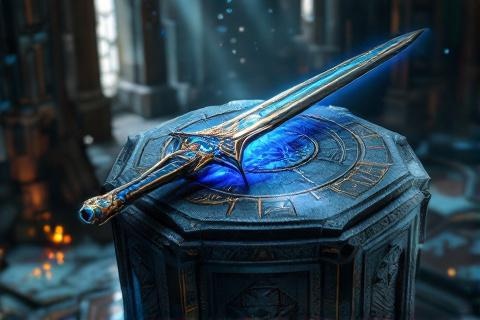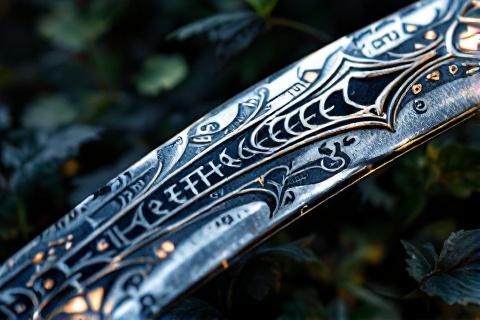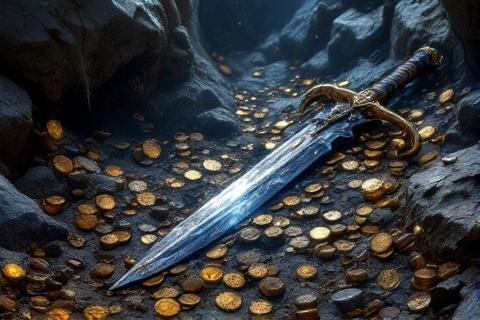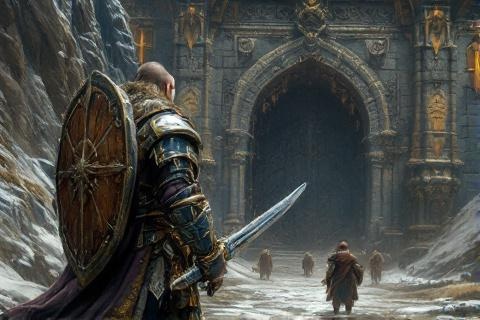
Orcrist: The Goblin-cleaver
Thorin Oakenshield's Famed Sword from Gondolin
Origins in the Hidden City

Orcrist was forged by the master weaponsmiths of Gondolin
during the First Age of Middle-earth, when that hidden
city stood as a bastion against the forces of Morgoth. The
Elven smiths of Gondolin were renowned throughout Beleriand
for their exceptional skill in crafting weapons of war, creating blades of
unmatched quality and magical properties.
The blade was crafted alongside its famous companion sword
Glamdring, the Foe-hammer, which would later become known
as Gandalf's sword. Both weapons were created in the same
forge, using identical techniques and materials, marking them as sister-swords
from one of the greatest periods of Elvish craftsmanship.
The smiths of Gondolin designed Orcrist specifically for the wars against
Morgoth's armies, incorporating enchantments and properties that made it
especially lethal against orcs and other evil creatures. The
blade's geometry and enchantments were carefully calculated to maximize its
effectiveness against the Dark Lord's forces, making it one of the most feared
weapons in all of Beleriand.
Physical Description and Properties

Orcrist features a distinctive curved blade that exemplifies the highest
achievements of First Age Elvish metalwork. The sword's exceptional sharpness
never dulls, and its durability surpasses that of normal blades, thanks to the
advanced forging techniques and materials used in its creation.
The sword bears intricate Elvish runes along its length, telling of its history
and deeds in the ancient realm of Gondolin. These decorative elements include
flowing patterns characteristic of Gondolin's artistic style, with the blade
featuring elegant curves and flourishes that reflect both its deadly purpose and
its status as a work of art.
Like its companion Glamdring, Orcrist possesses the magical property of glowing
with a cold blue light when orcs or goblins are nearby. This enchantment,
wrought into the blade during its forging, serves both as a warning system and a
psychological weapon against its intended foes.
The weapon's perfect balance makes it exceptionally effective in combat,
allowing for both powerful slashing attacks and precise thrusting movements. The
blade's weight distribution and ergonomic design enable the wielder to execute
complex fighting techniques with minimal effort, while its curved shape provides
additional cutting power during slashing motions.
The Name and Its Meaning
In the Common Tongue, Orcrist earned the name 'Goblin-cleaver,' a testament to
its deadly efficiency against the servants of darkness. This name was not merely
honorary but reflected the sword's actual history and purpose in the wars of the
First Age.
The blade earned its fearsome reputation during the numerous battles against
Morgoth's forces in Beleriand, where it claimed countless lives of orcs and
other evil creatures. Its effectiveness in combat and the magical properties
imbued within it made it one of the most renowned weapons of its time.
Among the orcs and goblins, Orcrist became known as 'Biter,' a name that struck
fear into their hearts whenever the blade appeared on the battlefield. This
reputation persisted even thousands of years after its creation, with the mere
sight of the sword causing terror among the goblins of the Misty Mountains
during the Third Age.
Lost and Found

When Gondolin fell to Morgoth's forces in First Age 510, Orcrist vanished from
historical record along with many other treasures of the doomed city. The chaos
and destruction that accompanied the city's fall scattered its artifacts across
Middle-earth.
For over six thousand years, Orcrist remained hidden from both history and
legend, its location unknown to even the wisest of Middle-earth's inhabitants.
The sword passed through unknown hands and places during this time, eventually
finding its way into a troll's hoard in Eriador.
The blade was finally rediscovered in the Third Age by Thorin
Oakenshield's company and Gandalf during
their encounter with three trolls in the Trollshaws. Along with Glamdring,
Orcrist was found in the trolls' cave, having somehow survived the ages with its
power and sharpness undiminished.
Thorin Oakenshield's Weapon

Upon its rediscovery, Orcrist became the primary weapon of Thorin Oakenshield
during his quest to reclaim Erebor. The Dwarf lord wielded the
ancient Elvish blade with great skill, despite the historical ironies of a Dwarf
carrying an Elvish weapon.
During the defense of the Lonely Mountain, Orcrist proved invaluable in Thorin's
hands as he led his people against their enemies. The sword's reputation and
effectiveness helped turn the tide of several crucial battles.
The blade demonstrated its ancient power most notably during the company's
encounters with the goblins of the Misty Mountains. The sword's magical
properties and fearsome reputation caused panic among the goblin ranks, proving
that even after thousands of years, Orcrist had lost none of its terror for the
creatures it was forged to combat.
Legacy and Final Resting Place

Following the Battle of Five Armies and Thorin's death, Orcrist was laid to rest
with its final wielder, placed upon his breast within his tomb deep under the
Lonely Mountain. This marked the end of the sword's active service in
Middle-earth's conflicts.
The blade was positioned with honor upon Thorin's tomb beneath Erebor, where it
lay as a symbol of both his leadership and the ultimate reconciliation between
Elves and Dwarves. The placement of an Elvish
blade in a Dwarf-lord's tomb carried great symbolic significance.
Even after Thorin's death, legends say that Orcrist continued to serve its
protective purpose, glowing within the tomb whenever enemies approached the
Lonely Mountain. This persistent enchantment served as a lasting warning system
for the denizens of Erebor.
Historical Significance
Orcrist stands as one of the exceedingly rare surviving artifacts from Gondolin,
representing a tangible link to one of the greatest Elven realms of the First
Age. Its preservation through the ages serves as a reminder of the glory and
tragedy of that hidden city.
The sword exemplifies the pinnacle of First Age Elvish craftsmanship, showcasing
the unmatched skill of Gondolin's weaponsmiths. The techniques used in its
creation were lost with the fall of Beleriand, making it an irreplaceable
testament to that golden age of Elvish craft.
As both an Elvish blade wielded by a Dwarf-lord and a treasure of Gondolin found
in a troll's hoard, Orcrist symbolizes the complex relationships between
Middle-earth's peoples. Its history represents the potential for alliance and
understanding between Elves and Dwarves, despite their historical differences.
